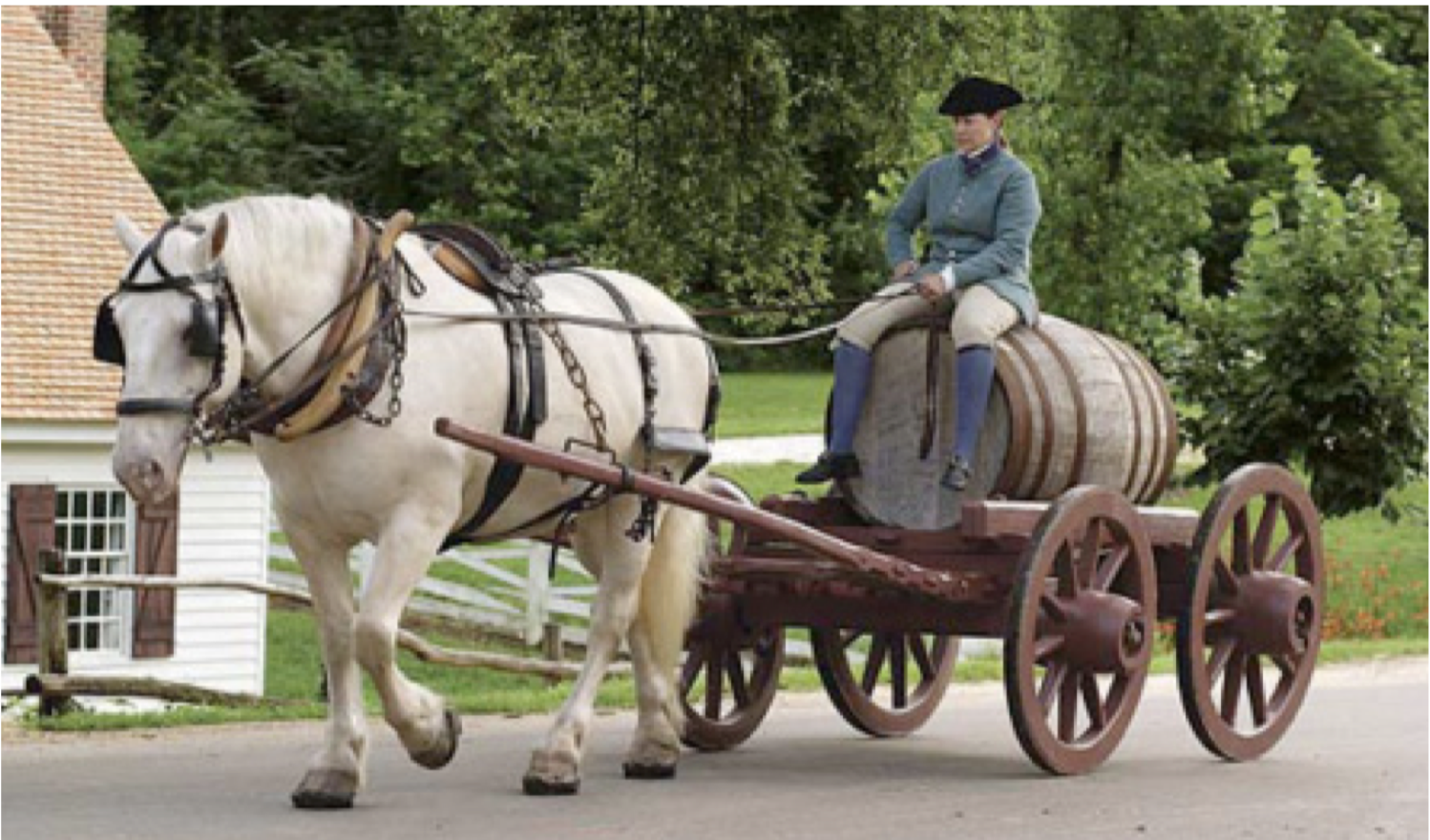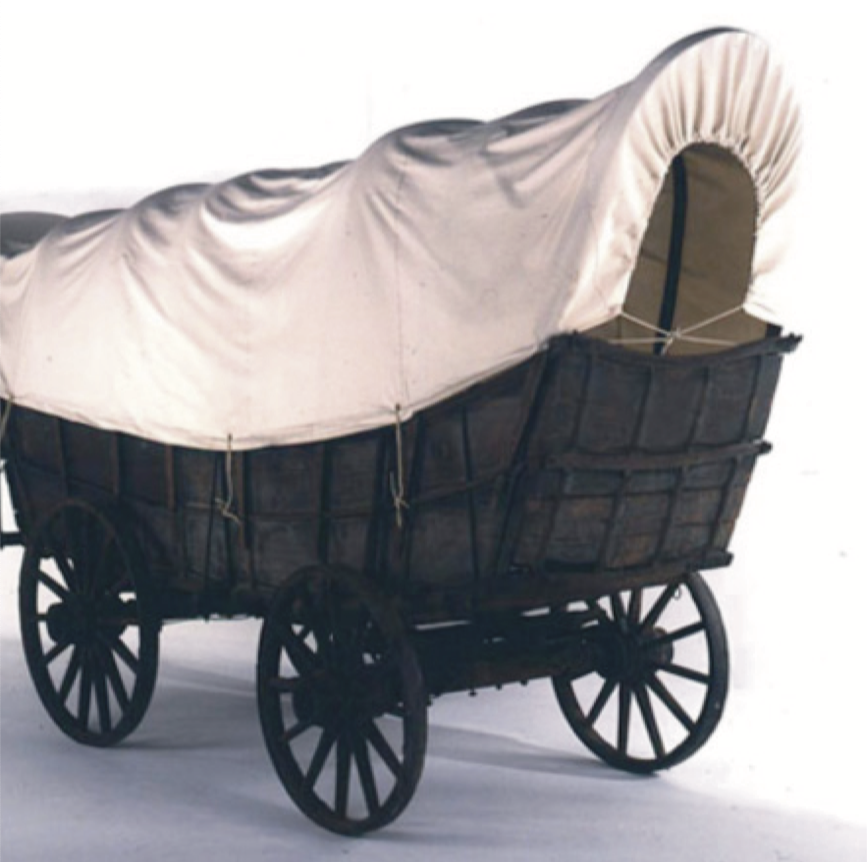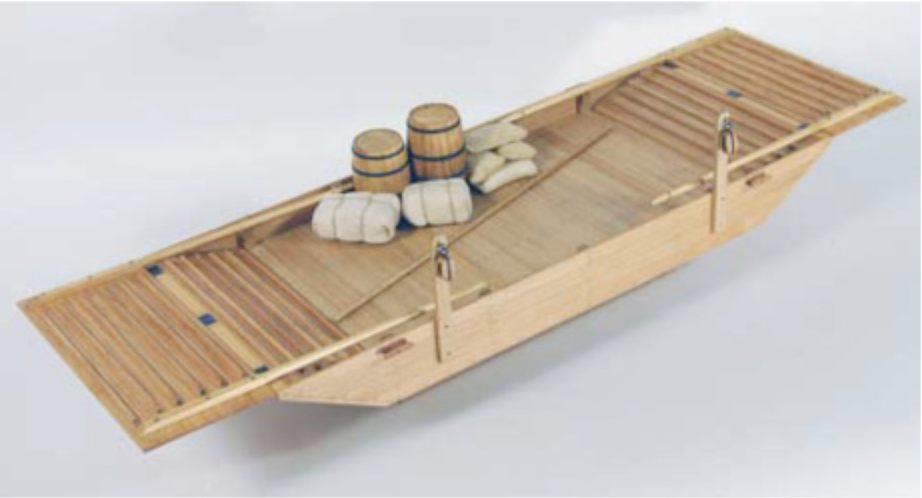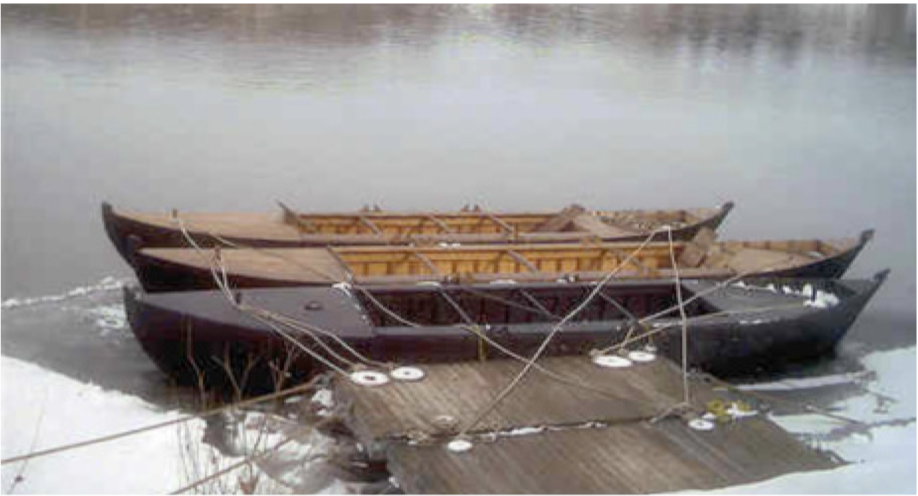by Joe Wagner
Logistics: “. . the branch of military science dealing with the procurement, maintenance, and movement of equipment, supplies, and personnel.”
PART TWO –TRANSPORT & FORAGE
The success or failure of a Quartermaster General (QMG) was largely judged on his ability to bring support to the troops while in winter camp and keeping them supplied on the move during the summer campaign.
The very center of the logistical problems of the Revolution lay in the transportation of equipment and supplies or the failure thereof. Washington later cited General Nathaniel Greene for the “great facility” he displayed in transporting and supporting the army from the Valley Forge camp to the Monmouth battlefield, and on to the Hudson Highlands in the 1778 campaign. His praise stands out as the exception amidst a difficult process that the Continental Army would never really master.
The policy throughout the war was to move goods by boat wherever possible. But the British navy largely controlled the seacoast, and the vast majority of supplies moved by road, even over such long distances as between the southern colonies and New England. In this Part II on Logistics, we’ll break down our discussion of Transport into Land and Water, followed by the topic of Forage.
As noted in Part I of this series, the army at Boston in 1775 did not require large amounts of transport, since they were in static positions besieging the city.
Nevertheless, Washington had designated a Wagonmaster General for the
Army in August 1775. His name was John Goddard, and he had already played a role at the start of the war for independence. It was he who delivered the arms and munitions from Boston to Concord that the British were after when they took the road to Lexington and Concord on April 19th, 1775.
When Boston fell in March 1776, Goddard’s work really began. Washington decided that New York was the likely target of British troops. It was necessary to quickly move the army to the threatened city. Goddard, using Washington’s influence, obtained from Massachusetts the loan of 300 wagons to transport the army. They were organized into 10 brigades of thirty teams each. The procedure for keeping track of supplies enroute set a pattern for future conduct of the transportation department. It was a common problem in transport in the colonies that portions of a load would disappear, being sold or abandoned by the driver whenever the opportunity or need arose.
To forestall this problem with the army’s goods, in addition to brigade wagonmasters, who were in operational command of the drivers and wagons, each brigade had a “conductor” serving as a freight agent, responsible for everything loaded in his 30 wagons. The conductor recorded each driver’s name, place of residence, and wagon contents. At the end of the journey, the conductor verified the arrival of the same contents at the New York camp. Once the driver had this bill of lading signed by the conductor, he would be paid for his work.
After the fall of New York, once again Washington had to call upon a colony for help. This time, New York authorized him to impress (take by force) whatever wagons and animals he could find in the counties of Duchess and Westchester, along his route of march. Apparently this provided little relief, since there was a great loss of materiel during the retreat across New Jersey in the fall of 1776. The original Wagonmaster General Goddard drops from the scene and apparently had returned to Massachusetts sometime before the battle of Long Island.
Congress provided authority for a Continental Army Wagonmaster General in the spring of 1777. Because of the capture of Philadelphia, the catastrophic departure of QMG Mifflin in the fall, and the delay in his replacement, no candidate took the field until spring 1778. As noted in Part I of this series, Mifflin’s failure to provide a Wagonmaster responsible for transporting supplies to Valley Forge was a key cause of the disaster there. This management failure combined with the poor quality of roads into and around Valley Forge. During the month of February 1778, not a single supply wagon reached the camp at Valley Forge.
“Almost every species of camp transportation is now performed by men, who without murmur, patiently yoke themselves to little carriages of their own making, or load their wood and provisions on their backs”
Letter from Congressional Committee to President of the Congress, Valley Forge, 12 February 1778.
In the spring of 1778, after General Greene had become QMG, a James Thompson was named as Wagonmaster General. We have no information on his background, but he had apparently been acting as a Wagonmaster for Washington in an unofficial capacity as far back as late 1777. He served as a civilian, with no military rank, until the reorganization of the department in 1780. We told in Part I of the tremendous growth of the QMG under Greene– and the wagon department was doing its share. Records indicate that by 1780 there were 125 wagonmasters overseeing some 450 wagoneers and packhorsemen with the main Army.
The vast majority of these drivers were enlisted men either taken from line units or from militia units as they were leaving Continental service. They were paid a bounty to join the wagon corps, plus a pay equivalent to line enlisted pay. Both Washington and his QMG preferred to obtain drivers from civilian sources – not drawing down the troop strength, but they simply could not pay the wages demanded by the civilian market. QMG Greene reported to Washington that his actual need was for over 1,000 wagoneers.
It’s instructive to look at the structure that Wagonmaster General Thompson was attempting to provide to the Army, to see how much transport a Continental regiment or brigade actually needed. The following details the number of wagons authorized per brigade:
Brigadier Commanding – 1, tools and equipment – 1, ammunition – 1, forges/blacksmith – 2, commissary – 4, forage – 4, line regiments – 4 each, (usually 4 regiments per brigade) – 16. Total of 29.
For the nineteen brigades of the main army, it means 551 teams, and this excludes the artillery, which had a requirement for over 230 teams of its own. The headquarters, engineers, sappers, cavalry, artificers, hospital, and other specialty units needed some 200 more. The grand total for Washington’s main army during the campaign of 1780 was 1,071 wagon teams.
As the war moved into 1779 and 1780, the lack of funds and massive depreciation of continental currency took its toll on transport. Where wagons were available, drivers could not be hired at the wages offered. Hard money was not available, and the usual source of animals and wagons – the local farmer – wasn’t available unless hard currency was offered. In April 1780, while still in winter camp at Morristown, NJ, QMG Greene informed Washington that there would be no transport to move his army into the field.
He simply did not have the men or animals under con- tract to do the job. In June, for the first time on a large scale, Washington resorted to impressments orders to obtain transport. He ordered Henry Knox into neighboring counties of Pennsylvania and New Jersey, where they seized some 250 wagons and teams to move supplies.
In September 1780, a line military officer was selected to serve as the main army Wagonmaster. He was Major Thomas Cogswell, and the transport task would be his until the end of the war. Another important change in 1780 was that, as noted in Part I, because of the failure of the QMG to obtain supplies without funding, the colonies were tasked with directly providing for the army’s supply needs, and the Wagonmaster’s department would carry those supplies to the army wherever it resided.
Transport for the campaign of 1781 was achieved by a combination of cajoling the colonial governments for men and wagons, promises of payment with specie, and the ever more necessary impressment orders. An example of the process survives in the form of an impressment order for 100 horses deliverable to the artillery (Knox), to be executed in certain counties of Pennsylvania. It was decided to use oxen teams for the normal army supply wagons, while saving the horse teams for artillery and cavalry support.
The needs for transport were completely transformed with the sudden decision in early August 1781 to move the entire main army to Virginia for an attack on the Chesapeake at Yorktown. No longer were movement needs measured in tens of miles. Suddenly the entire American and French forces must be quickly sent some 600 miles to Virginia. During August, the army trans- ported over 700 tons of supplies and equipment from throughout New York, New Jersey and Pennsylvania to the transshipment point at Head of Elk, MD on the Chesapeake. With the French fleet controlling the Chesapeake, most supplies could go by ship down to the James River below Yorktown.
It was decided to also send a wagon train south by land, since the availability of transport in Virginia was reported to be worse, if possible, than in New Jersey. At least 75 wagons were sent along this route. That the situation in Virginia had been reported accurately is obvious from orders issued by Washington from Williamsburg in mid- September that all officers should turn over their personal wagons or other transport for use in hauling ammunition to the Yorktown lines. Although the troops and much of their camp supplies arrived by ship, the transfer of the massive amounts of armament and supplies from the French fleet necessary for the siege had to be brought overland from the James river anchorage. It was not until the arrival of the wagons sent by land from New York, that this problem was solved in mid-October.
With the close of the Yorktown campaign, the need for large and immediate amounts of transport for the army greatly declined. For the rest of the war, the transport department used the practice of selling off livestock and material to finance the operations of the remainder needed to support the army until 1783 and the end of the war.
Water Transport.
The use of water as a transport vehicle was an established practice of the colonial settlers since the beginnings of America. The skills for building small river and lake-going craft were widespread among the colonists, and every- thing from canoes to schooners were plying the waterways of the eastern seaboard. The first use of shipping by the Continental Army even pre-dated the Boston siege, when in June 1775, sup- plies were shipped up the Hudson by schooner to Gen. Schuyler at Fort Ticonderoga.
Rivers and streams often impeded the movement of the army, since at the beginning of the Revolution there was not a single bridge over any significant river in the entire 13 colonies. Many smaller streams had bridges, but ferries were much more common. Floating bridges (pontoons) were sometimes constructed, but they required so much transport and effort, that often they could not be used in a timely manner.
Use of existing ferries, as with all things in the colonies, was on a cash basis. They were operated by independent owners, who charged by the trip, and the wider the stream to be crossed, the higher the fee. The army spent so much time along the Hudson River during the war that from about 1779, the QM department created its own ferry network, to allow free passage for continental forces. One of the Quartermaster’s responsibilities while on the march was to see that needed ferries were prop- erly manned and ready to transport the forces, and that lacking such, as many boats as needed were gathered to perform the task.
In 1779 the expanding QM under Greene created the Boat Department. By campaign season 1779, water transport available to the army included four schooners, seventeen Durham boats (similar to large pirogues), and numerous scows and rowboats. These resources were located at two ferry locations on the Susquehanna, one on the Potomac, two on the Schuykill, and other places along the Delaware about Philadelphia. Separate fleets were operated in New England and along the Canadian routes such as Lake Champlain.
By the time of greatest need – the Yorktown campaign of 1781 – these resources were greatly diminished. The first need was to move 7,000 American and French troops from the Hudson River area and New Jersey down to the Head of Elk for embarkation down the Chesapeake. The forces gathered at Trenton, on the Jersey side of the Delaware, and were moved by a fleet of approximately 30 scows and flatboats down to the Christiana Bridge (near present-day Newark, Delaware). From there they marched to Head of Elk.
To carry the army down the Bay, Washington person- ally enlisted every influential personage he knew in the Bay area. He had Robert Morris in Baltimore seeking ships from his merchant friends, the Maryland governor, Thomas S. Lee providing influence to assist, and to various Eastern Shore gentlemen and merchants who had vessels available. Movement of most of the army, its artillery, stores, and equipment, took place by water, moving from Head of Elk, Maryland down the Bay to the James River, Virginia, between September 10 and September 23, 1781. Once at Yorktown, it required a consider- able fleet to provide supplies and transport for the allied armies operating on the James-York River peninsula. There are several impressment orders issued during this period in Virginia, for boats to serve both the American army and to move goods from the French fleet to shore positions about Yorktown. As with land transport, the winding down of the war saw boats and equipment being sold off to support the much diminished needs of the last years of the war.
The Forage Department
If transport was the crux of the overall Continental supply problem, the heart of the transport problem was forage. If you could not feed the animals that pulled the wagons, nothing moved. In the opening year or two of the war, there was little involvement of the Army QMG in forage matters. Traditionally, the owners of the transport were responsible for forage for their animals. So long as civilian contractors made up the bulk of transport sources, the army had no need to involve itself. During the reign of QMG Mifflin (1775-77), nothing was done to provide consistent forage, even for the Army’s own animals in use by the cavalry and artillery.
By the end of 1777, deep in the supply disaster that be- came the winter at Valley Forge, Washington recognized the need for an organization devoted to supplying forage. He named Clement Biddle as Forage master for his army. By spring 1778, there were 45 members on his staff, responsible for gathering and distributing forage within the army. Forage magazines were established at Berks, Lancaster, and Northampton, PA, Chatham, Princeton, and Trenton, NJ, and a transfer station at Head of Elk to receive supplies from Virginia and Maryland.
The term forage was applied to the grains used to feed both horses and oxen. It consisted of corn, oats, hay, other grains, and wheat and by-products of wheat threshing. Wheat was last to be used, since it was also important to the feeding of the troops themselves. Throughout the war, there were always, in the mind of the Forage master, too many horses about the camp. There are continuous edicts that officer’s horses and other army support animals must be removed from the camp during winter stand-downs, so as not to require the import of vast quantities of forage.
The desired solution was to move the animals out into the countryside for wintering, allowing them to live on local grasses and hay, requiring much less transport and supply. Of course, the officers would have none of that. As quoted from Continental Army Brig, Gen. Alexander McDougall, “every branch of a department had horses sufficient for a Field Marshall’s suite.” It was also necessary to keep what animals and wagons were available at camp to move food and other supplies necessary for the troops.
The importance of forage was made evident in the wintering of the army in 1778-79. Due almost entirely to lack of animal forage, Washington had to disperse the army throughout New Jersey, the Hudson region of New York, Connecticut, and Rhode Island. Cavalry animals were moved as far away as Winchester. VA for the winter. The forage master estimated the total Continental Army horse population at over 10,000 animals. By spring 1779, the same problem of inflated currency and lack of any funding from Congress that hurt the other logistics areas also affected the forage department. Also, from four years of war, the middle colonies were greatly depleted of forage and the means to move it.
More and more, forage grains were shipped up the Chesapeake Bay from Virginia and Maryland through Head of Elk. In 1779-80, some 200,000 bushels of grain, mostly Indian corn, were sent from Virginia to Head of Elk. Britain’s off and on naval control of the Bay only added to the uncertainty.
As with the other logistical solutions, the use of impressments grew as other options failed. The state of Pennsylvania issued impressment authorizations to Washington in 1779, and direct impressments by the army without state authorization also became common. Washington always hated to do it, and was reluctant to order it be- cause he wanted the goodwill of the population. Virtually all of the forage obtained for the main army camp in 1780 was obtained by impressments. The disagreeable process involved can be glimpsed in a letter from QMG Pickering to Congress. The supply of forage at New York was obtained by “military authority which has lately occasioned bloodshed.”
From 1780 on, Congress solved the supply problem by handing it over to the individual states to support the forces in their areas. For the winter camp of 1780-81, which was in the highlands of New York, on the Hudson, western Massachusetts and Connecticut were to be the primary source of forage. To aid the effort, the Forage master Biddle moved large numbers of cavalry and supply animals to Berks and Lancaster County, PA. When the campaign of 1781 to Virginia got underway, once again impressment was the standard approach for forage supply. “a warrant of impress, I fear, will be for the most part your only resource.”
QMG Pickering to Deputy Forage master William Keese
To ease the pain for the Maryland and Virginia farmers and merchants from whom the supplies would be taken, the QMG issued 525 specie certificates, which served as promise of payment for items taken. By the end of the war, Washington and many other officers were purchasing their horses’ forage with their own funds.



